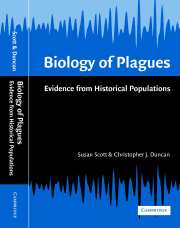Book contents
- Frontmatter
- Contents
- Preface
- Conversion table for imperial to metric units
- 1 Introduction
- 2 Epidemiological concepts
- 3 The biology of bubonic plague
- 4 The Great Pestilence
- 5 Case study: the plague at Penrith in 1597–98
- 6 Pestilence and plague in the 16th century in England
- 7 Plagues in the 16th century in northern England: a metapopulation study
- 8 Plagues in London in the 17th century
- 9 Plagues in the provinces in the 17th century
- 10 Plague at Eyam in 1665–66: a case study
- 11 Continental Europe during the third age of plagues: a study of large-scale metapopulation dynamics
- 12 The plague at Marseilles, 1720–22: an outbreak of bubonic plague?
- 13 Conclusions
- References
- Index
10 - Plague at Eyam in 1665–66: a case study
Published online by Cambridge University Press: 28 October 2009
- Frontmatter
- Contents
- Preface
- Conversion table for imperial to metric units
- 1 Introduction
- 2 Epidemiological concepts
- 3 The biology of bubonic plague
- 4 The Great Pestilence
- 5 Case study: the plague at Penrith in 1597–98
- 6 Pestilence and plague in the 16th century in England
- 7 Plagues in the 16th century in northern England: a metapopulation study
- 8 Plagues in London in the 17th century
- 9 Plagues in the provinces in the 17th century
- 10 Plague at Eyam in 1665–66: a case study
- 11 Continental Europe during the third age of plagues: a study of large-scale metapopulation dynamics
- 12 The plague at Marseilles, 1720–22: an outbreak of bubonic plague?
- 13 Conclusions
- References
- Index
Summary
The traditional story of bubonic plague at Eyam
The story of the plague in the Derbyshire village of Eyam is well known: the causative agent was brought in a box of cloths from London and when this was unpacked a rat and/or fleas jumped out and so brought bubonic plague. The inhabitants, led by their vicar, nobly drew a cordon sanitaire around their village, preventing all egress and ingress and so confined the epidemic to their little community. The events of this outbreak have been described in detail many times (Creighton, 1894; Batho, 1964; Shrewsbury, 1970; Bradley, 1977; Clifford, 1989; Race, 1995) but all assume without question that this was an outbreak of bubonic plague, although, as we shall see, the details of this epidemic demonstrate clearly that again, as at Penrith in 1597–98, it is a biological impossibility that Yersinia pestis was the causative agent.
The upland parish of Eyam is situated on the eastern edge of the Peak District towards the southern end of the Pennines, lying on the slopes above the Derwent valley. It was a remote and isolated spot 300 years ago and the approaches to the village were by rough and narrow tracks (Clifford, 1989). Bakewell, the local market town, lay 7 miles to the south. The main settlement in the parish was the village of Eyam with hamlets at Foolow (2 miles away), Grindleford Bridge (1.5 miles away) and Woodlands (2 miles away).
- Type
- Chapter
- Information
- Biology of PlaguesEvidence from Historical Populations, pp. 261 - 283Publisher: Cambridge University PressPrint publication year: 2001



